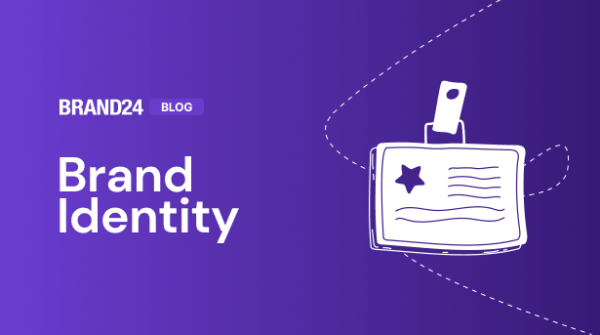9 Key Brand Metrics You Should Track in 2025
Table of contents
With countless metrics out there, it’s easy to feel overwhelmed. But no worries! I did the research for you and created a list of the most important brand metrics to measure. Analyzing them will help you to adjust your marketing efforts and perform better. Ready? Let’s dive in!
Brand metrics are key measurable indicators that help track your brand’s performance. They help you understand how your marketing strategies influence your brand health and image. By monitoring these metrics, you can make smarter decisions to improve your brand’s impact in the market.
Key brand metrics to track:
- Brand Awareness
- The volume of mentions
- Brand Sentiment
- Social media and non-social reach
- Customer Satisfaction
- Share of voice
- Net Promoter Score
- Brand Loyalty
- Brand Salience (Top-of-Mind Awareness)
01 Brand Awareness
Brand awareness is a crucial metric that expresses to what extent consumers can recognize your brand.
It’s essential for understanding your brand’s position in the market and its overall value.
Additionally, brands with high brand awareness are often more trusted by consumers. This trust is a significant advantage that can lead to increased sales.
This recognition also provides some kind of insurance against new competitors, as building brand awareness requires significant time and investment.
How to measure?
Measuring brand awareness is quite complex and involves detailed information about your brand performance.
- How many people engage with your brand on social media?
- How many visits your website has?
- How often do people search for your brand?
- How much is it mentioned in the media?
You should start by measuring more specific brand awareness metrics and then move on to calculating brand awareness in general.
This will give you a comprehensive view of your brand’s recognition and brand recall among consumers.
Remember, regularly monitoring brand awareness can help improve marketing strategies and enhance your brand’s market presence.
Track key brand metrics!
02 The volume of mentions
The volume of mentions is a crucial yet often underrated brand metric.
It measures the frequency and breadth of your brand’s presence in online conversations.
Those mentions are super valuable if you want to collect data about your brand usage, performance, visibility, and impact.
Why?
They offer insights into brand awareness, perception, and brand equity for a comprehensive understanding of your brand’s impact and health.
This data is invaluable if you want to enhance your brand value proposition, track brand growth, and maintain a strong brand presence in your industry.
Monitoring online mentions can:
- Indicate how recognizable your brand is in your target market.
- Help understand how consumers feel about your brand and its value in the market.
- Provide data on your brand performance and how well marketing efforts and strategies resonate with the target audience.
- Provide insights into brand health metrics.
- Show loyal customers and potential brand ambassadors, which are integral to brand growth and advocacy.
How to measure?
Social listening tools are the best way to go. They give you real-time feedback about what people think of your brand.
That’s how you can quickly jump into conversations, manage your reputation, and build stronger relationships with your target audience.
Take a look below. This is what a mention in the Brand24 dashboard looks like:

Plus, it goes beyond basics and monitors various online sources, such as:
- Social media platforms such as Facebook, Instagram, LinkedIn, YouTube, Twitter, TikTok, Reddit, Quora, Telegram, and Twitch
- Review sites such as TripAdvisor, Yelp, Booking, App Store, Google Play, Trustpilot
- Blogs
- Video platforms
- Podcasts
- Discussion forums
- Newsletters
- Online news sources
- Other publicly available sources
Brand24 can also detect anomalies in mentions volume. This feature indicates spikes in popularity or any issues requiring attention.
Just like this AI tool did for OpenAI and its last month’s shift:
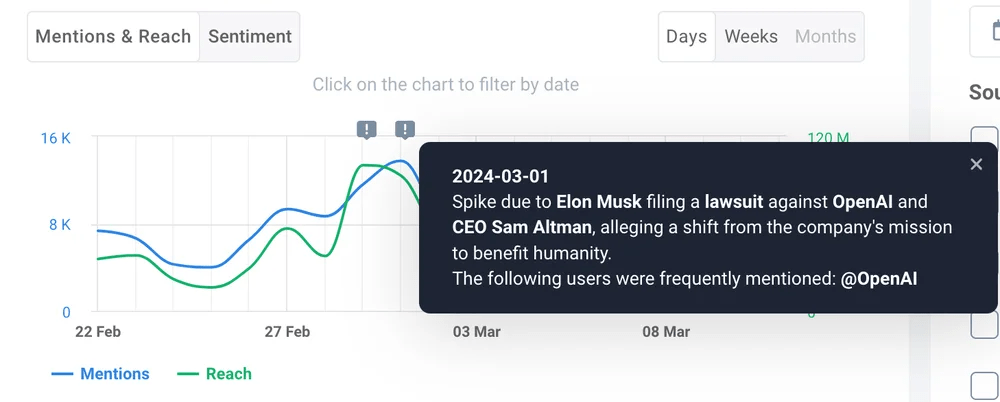
Track your brand mentions!
03 Brand Sentiment
Brand Sentiment is a metric that measures the emotional connection and attitudes people have toward your brand.
It’s not just about recognizing your brand but how people feel about it – positive, negative, or neutral.
You most probably have seen such comments:
“I love how Brand24 AI summary makes my reporting process easier.”
“The new AirMax model is nothing special. I think the grip is even worse than before.”
These all hold the emotional value that directly shows how people feel about your brand.
This metric is crucial as it influences consumer behavior, loyalty, and advocacy. Positive sentiment can lead to increased sales and brand loyalty, while negative sentiment can warn of potential issues that need addressing.
How to measure?
You can try to measure this metric manually… but I believe you’ll quickly realize it is super time-consuming without external media monitoring tools.
You must count every mention, read it, and identify its sentiment. Only then could you start analyzing the data. Plus, it’s an ever-changing process.
Sometimes, just one event can change the whole brand perception.
Remember Pepsi’s 2017 advertisement featuring Kendall Jenner?

It intended to convey a message of unity but instead was widely criticized for trivializing social justice movements.
This single ad campaign sparked an immediate public backlash, demonstrating how one misstep can dramatically alter perception and sentiment towards a brand.

Advanced tools can monitor sentiment in real-time, allowing you to respond quickly to negative comments and care for your brand’s health well.

Pro tip: In Brand24, you can access each mention directly from the tool’s dashboard by clicking on the “Visit” button. It’s also possible to mark the mention after replying so you won’t get lost in all those conversations and be ready to respond to new ones.
Plus, the tool provides you with some automatic AI features that analyze your brand perception:
- AI Insights
- Percentage breakdown of sentiment (positive, negative, neutral)
- AI-based emotion analysis (also presented in time or by source)
- Reach sentiment
- Source negativity

04 Social media and non-social reach
Social media reach indicates the extent of your brand’s presence across social media platforms.
It measures the total number of unique users who have seen content associated with your brand.
How is it useful?
This data provides insights into the scope of your brand’s online visibility.
Understanding social media reach is crucial in improving marketing campaigns’ effectiveness. By doing so, you can learn about the brand’s potential audience size and find ways to attract new customers.
The rule here is simple: the higher social media reach, the better brand recognition and engagement.
But even if you plan your marketing campaigns to be only on social media channels, they will likely go beyond that.
That’s why measuring non-social presence is also so important. You want to be aware of these conversations for successful brand reputation management and to adjust your branding efforts effectively.
How to measure?
Unfortunately, it is impossible to measure it without using advanced monitoring tools like Brand24, Hootsuite, or Sprout Social.
These tools can track mentions on social media and non-social websites like blogs, news sites, and forums. This approach lets you gather all data in one place and get a broad view of your online presence.
For example, with Brand24, you can track how your reach changes over time and use AI features to learn what exactly made your audience grow instantly:
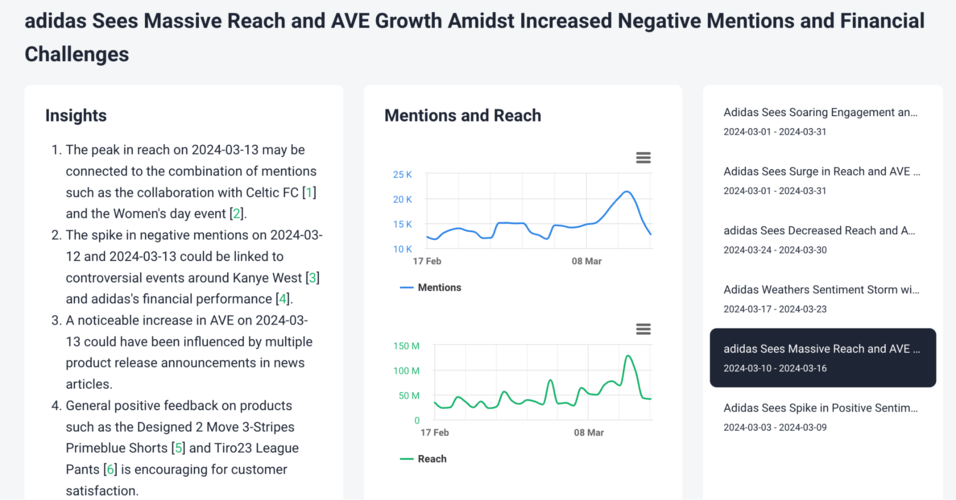
Track your brand reach!
05 Customer Satisfaction
Did you know that a whole 89% of businesses compete primarily on customer service?
So, the question is: Why?
Satisfied customers are more likely to make repeat purchases, with studies showing that they can contribute up to 65% of a company’s business.
Customer satisfaction isn’t just a nice-to-have. It’s a must-have.
And what about the flip side? Did you know a dissatisfied customer will tell 9-15 people about their experience?
That’s a lot! And a real danger to your brand’s reputation.
By monitoring customer satisfaction, you can extend your customer lifetime, increase sales, and boost your brand visibility.
How to measure?
Here’s a 3-step tutorial to follow:
- Conduct brand health surveys
It doesn’t have to be a complicated process. Just try regularly engaging with your customers to gather their opinions and experiences with your brand. You can do it via email, social media, or directly on your website.
But, ensure you use specific questions that directly address satisfaction with your product or service, the customer experience, and any interactions with customer service. - Analyze feedback
Collect and analyze the data from these surveys to identify trends, areas of strength, and areas needing improvement. - Implement changes
Use the insights gained from customer feedback to make necessary adjustments to your brand’s product or brand strategy.
06 Share of voice
Share of voice (SOV) is a key brand metric for marketing. It shows how visible your brand is compared to competitors.
The higher the SOV, the more authority you have within your business niche.
How to measure?
You can calculate SOV manually or use tools to measure it.
If you want to go manual – calculate it by dividing your brand’s metrics (like social media mentions, website traffic, link clicks, or paid advertising clicks) by the total in the market.
This will give you a percentage that represents your brand’s share in the industry.
Share of voice = (Your brand metrics / Total market metrics) x 100
I know it sounds a bit complicated.
You can leave this task to advanced tools and just check the final result. Here’s what it looks like in a Brand24 dashboard:
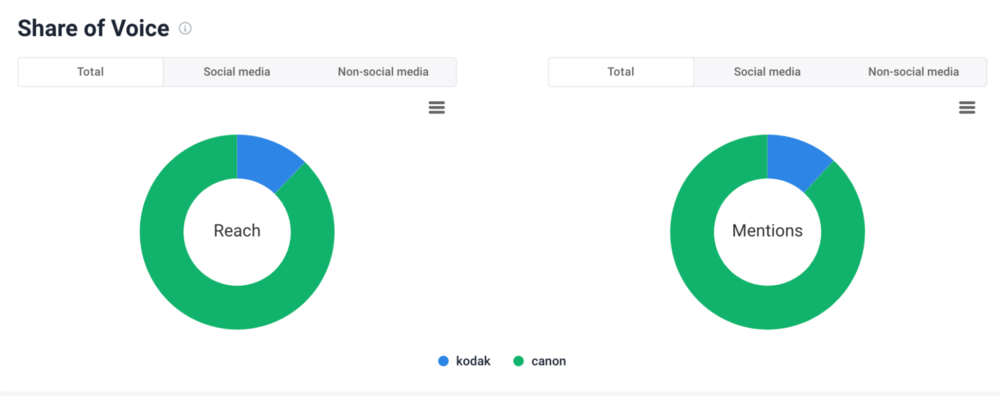
Measure your share of voice!
07 Net Promoter Score
This metric is all about measuring whether or not a customer would recommend your brand to others.
Keeping track of this score over time helps you understand how your customers feel about recommending your brand and shows you areas to improve.
How to measure?
You can use brand health surveys to measure Net Promoter Score (NPS).
It should include questions like:
- How likely are you to recommend our product or service to a friend?
- How would you rate your overall satisfaction with our product/service?
- How likely are you to purchase from us again?
- Do you feel our product/service offers good value for the price?
- How would you rate your experience with our customer service team?
The most important thing here is that you need to construct the questions in such a way as to enable the responses on the scale from 0 (very bad) to 10 (very good).
After getting the responses, calculate the NPS by subtracting the percentage of Detractors (respondents scoring 0-6) from the percentage of Promoters (those scoring 9 or 10). Passives (scoring 7-8) are crucial for context but don’t directly impact the score.
Track key brand metrics!
08 Brand Loyalty
Brand loyalty is a crucial metric that measures how much customers prefer your brand over competitors. It’s directly related to the number of returning customers. And these are often driven by positive experiences, satisfaction, and perceived value.
Measuring brand loyalty is important because loyal customers are more likely to make repeat purchases, advocate for your brand, and provide stable revenue streams.
Plus, they often act as organic ambassadors, influencing others through word-of-mouth.
How to measure?
Start by analyzing your customers’ purchase history to spot trends in repeat purchases.
Frequent buying is a strong sign of loyalty
You can also dive even deeper by calculating the Customer Lifetime Value (CLV). This metric sums up the total worth a customer brings over their entire relationship with your brand.
The rule here is simple: A higher CLV indicates greater loyalty.
Finally, examine your customer retention rate – how many people stick with your brand over time, which is a key loyalty indicator.
Understand your customers!
09 Brand Salience (Top-of-Mind Awareness)
Brand salience measures how often and easily a brand comes to mind in a buying decision.
It’s all about the prominence of a brand in a consumer’s mind when considering a purchase. High brand salience means that the brand is thought of first or is ‘top-of-mind’ in a particular category.
For instance, if people think of Pepsi, when thirsty for a soft drink – that brand has high salience.
How to measure?
A super easy way is to use Brand24 and check an ‘Online Presence Score’. This score tells you how visible your brand is online by looking at how often and where it’s mentioned.
It’s a great way to see how well your brand sticks in people’s minds.
Another, yet more time-consuming way is to do surveys and ask customers for brand associations they think of first in your category.

Track your Presence Score!
Tip: Advanced tools can analyze metrics for you
As you can see, you can track your brand metrics in many ways. Some are more efficient and others not so much.
I suggest considering how much time and money you’d like to spend analyzing brand metrics.
If you’re looking for the most efficient way – advanced tools are the way to go. These can analyze the data and spit out conclusions so you don’t have to waste time on your own analysis.
Here’s an example. Brand24 provides its own Metrics Analysis tab with pre-calculated AI charts and insights.
This is what a brand metrics summary can look like:

It includes all the important information about trends, sentiment, or big events. Plus, it also mentions some crucial stats.
Another very helpful feature is the mentions sentiment analysis. The tool automatically detects which source generates the most negative sentiment:

Impressed? Well, it can also identify actual emotions associated with your brand. It’s a fantastic tool to understand your brand perception better.

And finally, here’s a feature for market share monitoring. The tool detects which source is the most reach efficient:
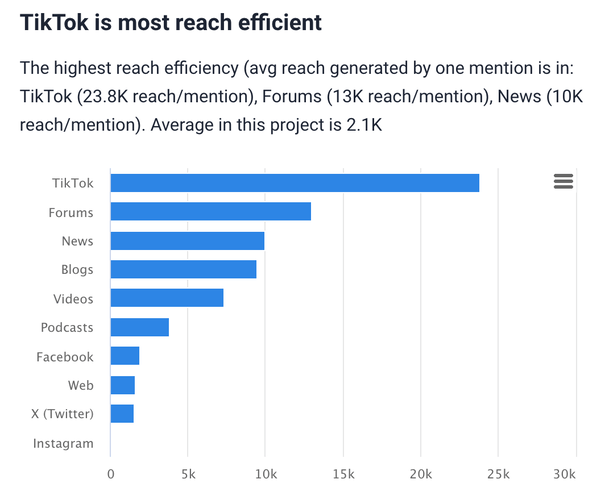
Track key brand metrics!
Conclusion
Each metric can be valuable if measured right. Remember – the goal isn’t just to gather numbers but to translate this data into actionable insights and understand your consumer perspective.
I suggest using advanced tools to measure and analyze your brand metrics data. They can simplify this complex task and turn raw numbers into understandable insights with just a few clicks. It’s a massive save of time!
So, ready to take your brand to the next level? Start with a Brand24 trial and boost your market share.
Related articles



![How to Measure Brand Performance? [2025]](https://brand24.com/blog/app/uploads/2023/11/Brand_Performance-_@2x-600x335.webp)
![How to Measure and Increase Brand Visibility? [2025 Guide]](https://brand24.com/blog/app/uploads/2024/03/brand_visibility-600x335.webp)
